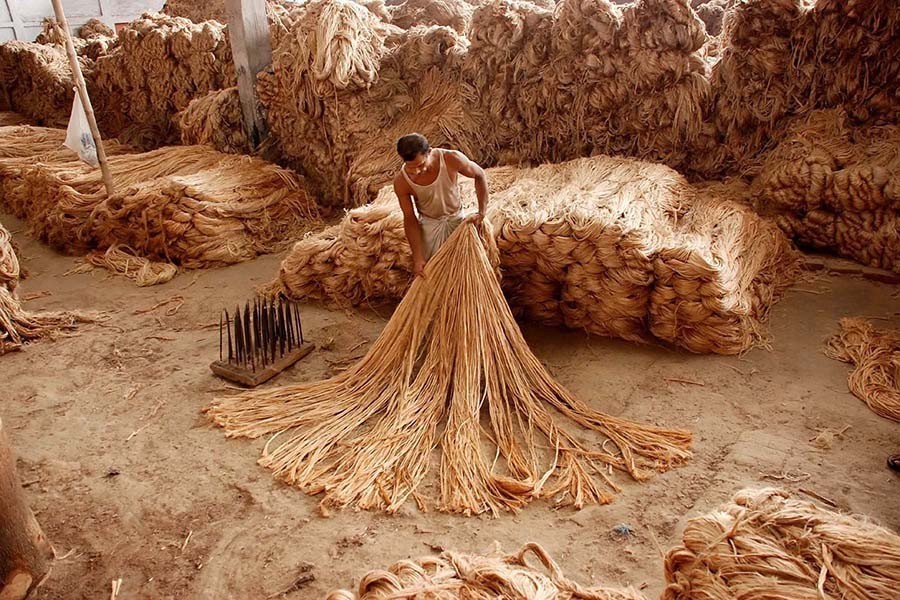Squeezing jubilation and elements of emotional upsurge out of every possible event and product is innate with this nation. At times the trait becomes anachronistic, but a large segment in society continues to stick to it almost ritually. This overt enthusiasm often results in disillusionment and, finally, disappointment. But overoptimistic gestures reign supreme to emerge, finally, as mere inanities. Jute is a case in point. Over the last one-and-half decades, upbeat portrayal of the product's future has been a periodical exercise. The way the crop's prospects have kept being projected, people from all strata, farmers and jute millers in the main, couldn't wait to see the much-anticipated revival of the product both at agro- and industrial levels. Pro-green environmental movements worldwide played a critical role in these expectations. As a result, the jute-based agriculture underwent phases of resurgence in Bangladesh and the other jute-growing countries. The developments reached such a pitch that many farmers in this country switched back to their ancestral agro-practice of jute cultivation.
What followed eventually was a bumpy progress in raw jute production. The treatment the finished crop met in the trade sector and the jute goods' lukewarm acceptability among the consumers need no elaboration. However, a significant event related to jute had taken place by that time. In the face of wholesale blame placed on the inorganic polythene and plastic products for causing environmental hazards, the industrial countries turned to the jute-producing nations. Scientists declared jute a purely biodegradable product, unlike the non-biodegradable polythene that had been singled out as a chief culprit behind myriads of ecological adversities. In Bangladesh itself, polythene products emerged with vengeance by causing hindrance to smooth flow of water. During monsoon in Dhaka and other large cities, dreadful polythene leftovers continued to choke drainage, canals and small rivers. All this resulted in water-logging and the submerging of low-lying city areas.
The government policy makers' all-out efforts to put in place an effective jute policy raised hope among the many stakeholders. The farmers comprised the major segment of them. Meanwhile, against the increasing demand of jute goods in the developed and fast-developing world, their export prospects continued to demonstrate a rising trend. However, it didn't take long for the demand to fall. Latest information has it that the awkwardly emerging new overseas market for Bangladesh jute is on the plunge.
By the National Jute Day 2019 last Thursday, the country's jute sector found itself in the doldrums. Troubling news about jute now fills the air. It stands in contrast to the fresh hopes pinned in the revival of the fabled 'golden fibre'. Given the signs of the heyday awaiting jute, the Prime Minister on the Jute Day spontaneously stressed branding the country's jute goods overseas in order to explore markets. The premier appealed to all concerned to take necessary steps to make the jute sector profitable. Her optimism stemmed especially from the recent vibrancy that has been seen in the country's jute sector. But the elements of gloom had lately pervaded the sector. It began insidiously; now it is about to complete a cycle. The ominous news is fund crunch has hit BJMC (Bangladesh Jute Mills Corporation). The entity has been crippled to such an extent that it is unable to buy raw jute from the farmers this year. The peak harvest season is fast passing by. Due to the dearth of jute, the jute mills are being made to cut down production by nearly 66 per cent. The murky development amply demonstrates the extent of the sector people's 'endeavours' in the revival of the virtually lost case for the crop.
At a time, when the government is spending huge sums of money on its ambitious programmes on jute, delay in fund allocation for the state-run BJMC sounds preposterous. It is presumed that this failure to buy raw jute from farmers will lead to productivity losses of the mills that operate under BJMC. In such a disheartening situation, jute sector experts have ample reasons to give up on any bonanza from jute export. Why only them and the green activists --- even the moderately educated persons may have no illusion about the revival of the Bangladesh jute.
In spite of the spectacular fanfare, seminars and displays of jute-made products coupled with high expectations, the Jute Day makes little stir among the jute growers, the weary millers and trade circles. But all this follows a series of outstanding events centring on the jute crop. One of them is jute genome sequencing by Bangladeshi scientists, with the other being the invention of biodegradable jute-made polythene in the country. Ironically, nothing is helping the moribund 'cash crop' come out of its adverse state. For an agro-product to appear fruitful to the people, it ought to pass through pragmatic processes. It's true with jute and the products made of it.
After a glimmer of hope seen in the country's jute growers, as well as traders, caused by the moderate rise in its overseas demand, the farmers in 2019 seem to be relapsing into its earlier state of abysmal hopelessness. Over the last few years, the jute sector revival programme has seen rhetoric and promises on the part of policy makers. In fact, except the genome sequencing nothing seems to have been done that will invigorate the jute farmers and traders. Given the lackadaisical manner in which jute is being dealt with, the crop is feared by many to go extinct. It could also be the other way around, because the country has no dearth of enthusiastic jute-growers. Moreover, it doesn't lag much behind other countries in the field of innovative research.


